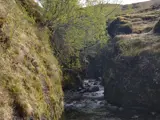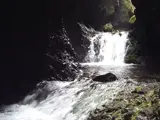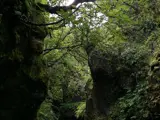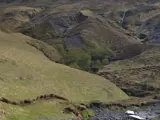Lies under the Eyjafjöll volcano
Nauthúsagil
Nauthúsagil (“Bull Shed Ravine”), which lies under the Eyjafjöll volcano, probably derives its name from an original building of a bull shed from the farm Stóru-Mörk. Back then bulls were put out to pasture along with other non-milking stock. An outlying farm called Nauthús was later built, but abandoned in 1770. Nauthúsagil is known for the rowan (Sorbus aucuparia) that grows on its ridge and whose multiple trunks lean over the ravine, some almost horizontally. It’s an impressive sight, especially when the tree is in full bloom. Frequently, the sheep gather close to the roots, providing the rowan with fertilisation. The wood is said to be holy and it is considered bad luck to cut it. The rowan’s exact age is unknown. When its main trunk broke in 1937, the trunk and the biggest branches were cut down and carried off on eight horse carriages. Part of the trunk is now on display at the Skógar Folk Museum and when analysed, it turned out to have been over 90 years old when it broke.
Although the ravine is deep and narrow, you can walk along the river while keeping your feet relatively dry. Walk along the ravine until you come to a 2-3 metre high waterfall. You can climb the rock beside it if you want to. If you continue on your way, you come to a yet larger waterfall which is a sight to behold. You can also walk along the western edge of the ravine where you have a good view of the ravine and a third, beautifully shaped waterfall. You can also enjoy the sight of the Markarfljót catchment area, Stóri-Dímon and Fljótshlíð.
Geology
Nauthúsagil is carved into tuff at the bottom, with hackly jointed lava further up and interglacial lava at the top of the ridge. This combination of geological layers continues along Merkurnes and beyond Innra-Akstaðagil ravine. Rain and wind has caused much erosion in the area so ravines and gullies frequently cut across the tuff. Hackly jointed lava and pillow lava are more resistant to erosion and many peculiar formations can be seen in the areas where these are dominant.
The Legend of the Nauthús Brothers
Three brothers resided at the farm of Nauthús along with their sister. When the most kind-hearted one was killed by his wicked brothers, their sister fled to Stóridalur. She got engaged to the farmer there, much to the displeasure of the brothers, who vowed to kill him. One winter's day, as the farmer was rounding up his sheep near Markarfljót River, which was frozen except for the deepest part, the brothers attacked him, forcing him to retreat onto the river. The brothers drowned when they tried to follow him, but the farmer escaped unharmed. Nauthús had few inhabitants during what remained of winter, but those who were there became aware that the brothers were not fully departed from this earth. In the spring, their sister convinced a kinsman of hers to move to Nauthús. Nothing remarkable happened during the summer, but with winter darkness came many apparitions. The farmer at Nauthús sent for the Stóridalur farmer, who came and spent the night there. Everything was quiet that night, but at dawn, a farmhand from Stóridalur came to report that ghosts had appeared there that night. The ghosts returned to Nauthús the following night and mounted the housetops every night that week. The Stóridalur farmer served as the trustee of the church there. One night, he went alone into the church and one of the ghosts appeared behind him. The farmer asked it to not kill him quite yet, as a girl in Mörk was expecting his baby and they would meet their end at the hands of the child she was carrying. He advised them to kill her, as well as himself, the following night. The ghost agreed to this and left. The farmer fetched the girl and told her to stay behind the altar steps during the night. He then spread holy water all over the church except for a narrow path across the church floor. When the ghost appeared after nightfall, the farmer followed him across the floor, consecrating the path behind him. The ghost could not go beyond the altar steps and the holy water prevented him from going back. The ghost then sank into the ground where it stood. The farmer placed a cross on the spot so the ghost was never seen again, as ghosts forced into the ground where they stand can only re-emerge in the same spot. The other ghost, however, returned that night and the following nights, causing the farmer to flee. Nauthús has remained abandoned ever since and is believed to be still haunted.
Celebrating Earth Heritage
How to visit the Katla Geopark
Katla UNESCO Global Geopark is in central South Iceland



